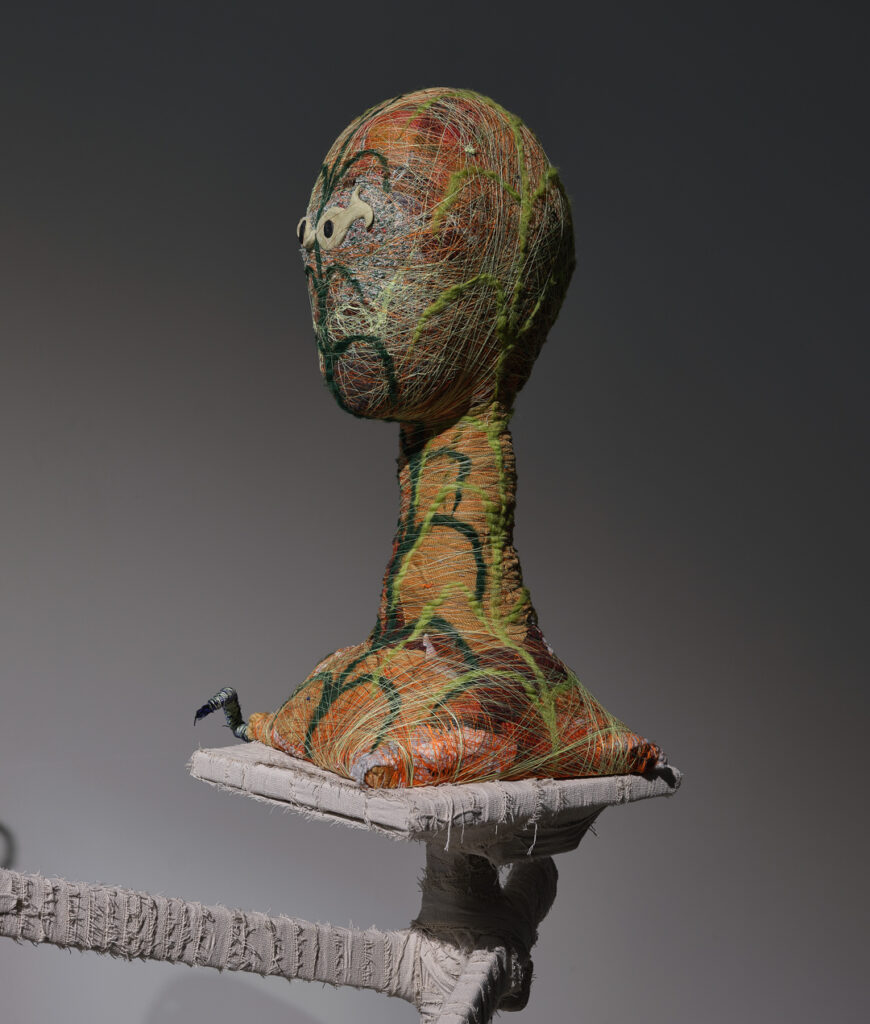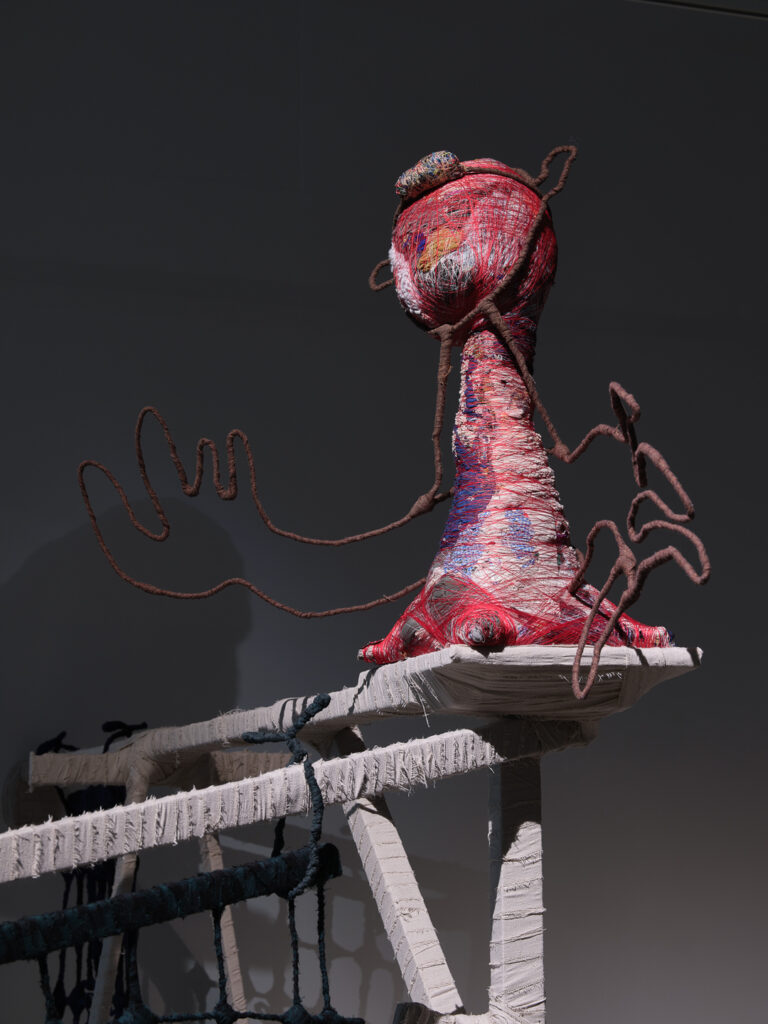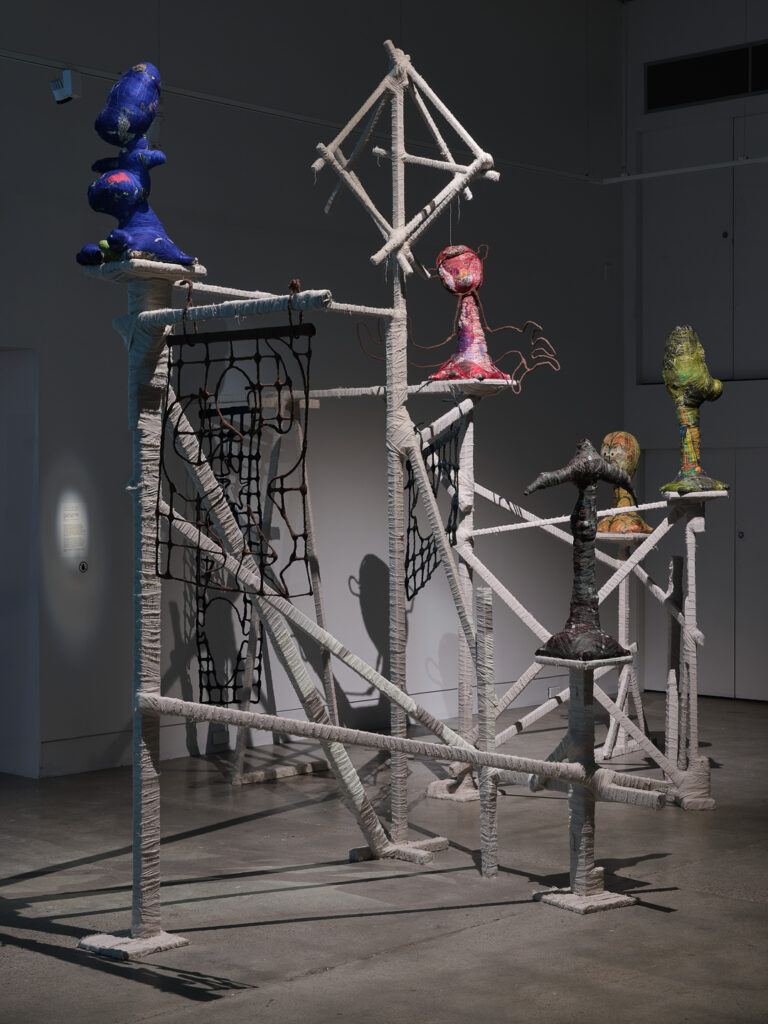
Tyrone Te Waa, Te Wā, Ringaringa, Garage, Hinengaro, Bones, La Fibra, Ngākau and Rākau installation views and details. 2022. Courtesy of the artist and Dowse Art Museum; photo: Sam Hartnett and Mark Tantrum
Karl Chitham bears witness to intricately woven works by Tyrone Te Waa that honour the Māori tradition of elevating the ancestors.
In late August 2022 Tyrone Te Waa travelled to Te Awakairangi Lower Hutt, Aotearoa New Zealand to install his work Te Wā, Ringaringa, Garage, Hinengaro, Bones, La Fibra, Ngākau and Rākau as part of the exhibition Whetūrangitia/Made As Stars at The Dowse Art Museum. Featuring thirteen artists from Aotearoa, Nepal, Canada, Hawai’i, Sāmoa, Tonga and Laos, this exhibition explored the real-time, lived relationships first cultures have with their ancestral gods. Through the retelling of histories, each of the artists generously shared the concepts, practices and belief systems of their cultures.
Within this diverse mix, Tyrone’s work offered a unique tactile perspective that utilised found, discarded, and repurposed materials with a particular focus on fibre and textiles. This was his largest installation to date, which brought together hard and soft sculptural elements to create a structure that became a focal point for the exhibition. While Tyrone’s working process usually involved him labouring alone in his studio garage to manifest the curious forms of his busts and screens, it was the construction and covering of the timber framework elements that offered a surprising opportunity for others to share in his process and understand the unique qualities of working with cloth.
Upon arrival at The Dowse Tyrone asked to see the timber off-cuts we had been putting aside for him over the months leading up to the show. Each rejected and redundant baton was inspected diligently for its new purpose. Tyrone then methodically erected his wooden assemblage, making alterations and adjustments as he went. A team of helpers were invited to assist with wrapping these “bones” with a “skin” made from strips of off-white canvas drop-sheets. In an almost ritualistic way, we wound the mummy-like coverings studiously around and around these rigid forms—one helper describing it as “meditation through repetitive action”.
Tyrone has defined his practice as “knowledge weaving”, suggesting that the maker’s hands breathe life and transfer generations of experiences into the materials in a way that is absent from mechanical processes. The touch and feel of creating the works is an intuitive process for Tyrone. By employing methods of hand-tying, binding, concealing, knotting, tangling and fastening Tyrone has created a language of the hand that links him directly to his tūpuna (ancestors). It is transformative on a personal level as a way of transcending non-indigenous notions of time and space, but it also welcomes others to take part in their own way.
Of Tūwharetoa, Ngāti Maniapoto and Ngāpuhi ancestry, Tyrone’s practice is an expression of his whānaungatanga (family relationships), referencing his tūpuna and atua (gods) while embracing those who are still to come. This system of connections reflects a well-known whakataukī (saying) “Ka mua, Ka muri” (walking backwards into the future) suggesting that time for Māori is not a linear concept but one that shifts and moves, and where past, present and future can all exist simultaneously like the threads that circle and overlap many of Tyrone’s forms. These ideas are also present in the connections that come with raranga (weaving) and other textile-related practices that are most closely associated with maternal lines and express the deep cultural traditions that fibre symbolises across generations and between the physical and spiritual realms.
This sense of association was accentuated during the period of installation. As we helpers sat or stood wrapping and twisting in the dark gallery spaces, receiving quiet direction from Tyrone at each step, there was a feeling of peacefulness in our collective effort. At one point, Tyrone asked me to help repair one of the new screen works that would be suspended from his timber and canvas structure. He demonstrated how to twist and turn the fabric in a way that covered the wire armature while also becoming its own unique textural form. It takes me some time, through trial and error, to find the perfect balance of control and instinct to replicate Tyrone’s seemingly effortless understanding of the materials.
The installation is punctuated by individual works. The screens that hang between structural components offer support to Tyrone’s signature busts that are mounted stoically on small platforms. These figures are non-specific in their appearance: some have recognisable head-like shapes and face-like features while others sprout appendages that could be wings or jazz-hands. Protuberances morph from familiar to alien as you move around them. The thing they all share is the deep investment of time spent in the winding of continuous strands to build these figures line by line into personality-filled characters that Tyrone has described as a “gateway to memorialise my thoughts and experiences.”
- Tyrone Te Waa, Te Wā, Ringaringa, Garage, Hinengaro, Bones, La Fibra, Ngākau and Rākau installation views and details. 2022. Courtesy of the artist and Dowse Art Museum; photo: Sam Hartnett and Mark Tantrum
- Tyrone Te Waa, Te Wā, Ringaringa, Garage, Hinengaro, Bones, La Fibra, Ngākau and Rākau installation views and details. 2022. Courtesy of the artist and Dowse Art Museum; photo: Sam Hartnett and Mark Tantrum
- Tyrone Te Waa, Te Wā, Ringaringa, Garage, Hinengaro, Bones, La Fibra, Ngākau and Rākau installation views and details. 2022. Courtesy of the artist and Dowse Art Museum; photo: Sam Hartnett and Mark Tantrum
- Tyrone Te Waa, Te Wā, Ringaringa, Garage, Hinengaro, Bones, La Fibra, Ngākau and Rākau installation views and details. 2022. Courtesy of the artist and Dowse Art Museum; photo: Sam Hartnett and Mark Tantrum
The entire installation references a Māori architectural tradition called whata (“elevation”). Like stages, these arrangements made from wood and historically lashed together with fibre represented moments of respect. Some of these structures would be two or three stories high and would display the wealth and hospitality of the host iwi (tribe) to visiting manuhiri (guests). Another form of whata, however, was more personal. Recently deceased whānau (family) would be placed on these platforms, high in trees, before eventually being laid to rest in caves or other sites of interment. Tyrone’s intricately hand-woven busts are not necessarily representative of either of these specific subjects but are more an embodiment of the connections we have with our tūpuna and acknowledging their mana (status).
As the installation progressed, and helpers came and went in their various tasks, it became clear that this moment of connection was coming to an end. While visitors to the exhibition may not have recognised it, this enshrouded skeletal form was not a haphazard arrangement of components but was a lesson in the harmony and balance that comes with being open to following your gut and listening to your instincts. As we completed wrapping a length, we were confronted with the conundrum of the awkward angles of platforms, cross beams or joins. Under Tyrone’s patient guidance, our fingers folded, tucked and smoothed the cloth endeavouring to mimic the same fluid approach he had used in other places. With a final flurry of activity, we searched the structure for any holes or untidy moments. It became second nature to run your hands over the surface, feeling rather than seeing where adjustments needed to be made. Some of us stayed to watch as Tyrone placed his busts and screens in their allocated positions, giving the “body” of this installation the gift of sight. These last gestures end the helper’s physical relationship with this work as it is handed over to be cared for by the gallery and the ability to touch the work is removed. It is only during the karakia before the exhibition is opened for the public that we are able to feel the texture of the canvas one final time—a moment to savour and a memory to keep.
About Karl Chitham
 Karl Chitham ONZM is the Director of the Dowse Art Museum and Head of Arts and Culture for Hutt City Council, Te Awakairangi Lower Hutt. He has written for multiple arts publications including co-authoring the ground-breaking publication Crafting Aotearoa: A Cultural History of New Zealand and the Wider Moana Oceania.
Karl Chitham ONZM is the Director of the Dowse Art Museum and Head of Arts and Culture for Hutt City Council, Te Awakairangi Lower Hutt. He has written for multiple arts publications including co-authoring the ground-breaking publication Crafting Aotearoa: A Cultural History of New Zealand and the Wider Moana Oceania.





